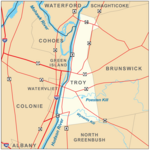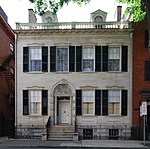Troy is a city in the U.S. state of New York and the county seat of Rensselaer County. The city is located on the western edge of Rensselaer County and on the eastern bank of the Hudson River. Troy has close ties to the nearby cities of Albany and Schenectady, forming a region popularly called the Capital District. The city is one of the three major centers for the Albany metropolitan statistical area, which has a population of 1,170,483. At the 2020 census, the population of Troy was 51,401. Troy's motto is Ilium fuit, Troja est, which means "Ilium was, Troy is".Today, Troy is home to Rensselaer Polytechnic Institute, the oldest private engineering and technical university in the US, founded in 1824. It is also home to Emma Willard School, an all-girls high school started by Emma Willard, a women's education activist, who sought to create a school for girls equal to their male counterparts. Due to the confluence of major waterways and a geography that supported water power, the American industrial revolution took hold in this area, making Troy reputedly the fourth-wealthiest city in America around the turn of the 20th century. Troy, therefore, is noted for a wealth of Victorian architecture downtown and elaborate private homes in various neighborhoods. Several churches have a concentrated collection of stained-glass windows by Louis Comfort Tiffany. Troy is also home to the world-renowned Troy Music Hall, which dates from the 1870s and is said to have superb acoustics in a combination of restored and well-preserved performance space.
The area had long been occupied by the Mahican Indian tribe, but Dutch settlement began in the mid-17th century. The patroon, Kiliaen van Rensselaer, called the region Pafraets Dael, after his mother. The Dutch colony was conquered by the English in 1664, and in 1707, Derick van der Heyden purchased a farm near today's downtown area. In 1771, Abraham Lansing had his farm in today's Lansingburgh laid out into lots. Sixteen years later, Van der Heyden's grandson Jacob had his extensive holdings surveyed and laid out into lots, naming the new village Vanderheyden.
In 1789, Troy adopted its present name following a vote of the people. Troy was incorporated as a town two years later, and extended east across the county to the Vermont line, including Petersburgh. In 1796, Troy became a village and in 1816, it became a city. Lansingburgh, to the north, became part of Troy in 1900.










